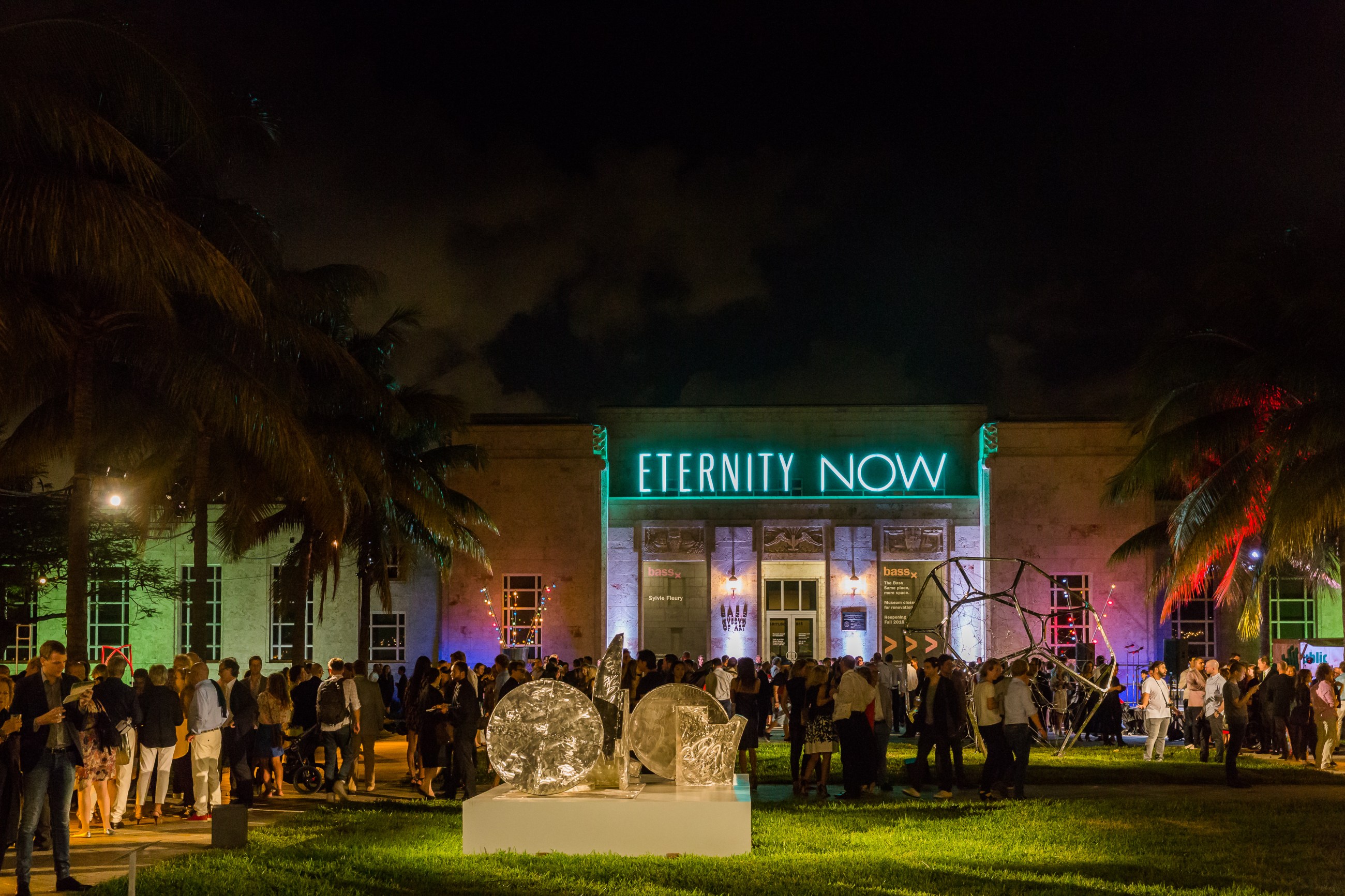
A mantra for Art Basel Miami Beach 2015: ‘Eternity Now’
Photo: Art Basel Miami Beach 2015, © Art Basel.
As the world grappled with shootings, bombings and elections, for a few days in December, Miami once again became the hub of the art world. For fans of contemporary art, the boundless Art Basel fair and its many satellites offer the best excuse to visit our Florida metropolis (and, for some residents, the best excuse to leave town). This year, as a result of global warming, El Niño or plain bad luck, it rained in December as never before, soaking several celebrity parties and adding more inconveniences to our exasperating traffic nightmares. Not to be outdone by other events, there was also an impromptu, Puccini-like performance in which a young woman stabbed another in the middle of the fair, sending her to the hospital and horrifying those who thought they were witnessing a piece of performance art.
Despite the incident, Art Basel itself, staged at the Miami Beach Convention Center, stayed peaceful in the eye of the storm as the satellite fairs struggled to survive and prevail–we know that the further from the eye, the stronger the winds. There were never so many fairs, nor so many visitors (77,000). Among the 20 or so fairs positioned around the city, at hotels and various fairgrounds, Art Miami and its twin, Context, were the most popular, breaking attendance records and achieving sales that placed them solidly in the lead. In fact, a significant percentage of attendees (and collectors) seemed to prefer them to the main event–or perhaps they finally decided to make purchases that would be prohibitively expensive at Art Basel. Boasting a few world-famous galleries, the multi-colored disarray of the satellites also made them more livable, more accessible compared to the impeccable Swiss order of their elder sister.
Nevertheless, the ivory tower that Art Basel represents is still a vanity fair where one has to desperately seek substance–something made more challenging by the nonsensical fad, adopted by some top galleries, of neither naming nor attributing pieces, assuming patrons should already know. Fortunately, quality was high and consistent, with minor excesses and solid offerings that could dazzle any collector. In this edition of the world art emporium, sustained quality prevailed over the merely spectacular. Painting continued to dominate, but the menu was lengthy and varied, and it was worth discovering jewels hidden behind the stifling façade of glamour and opportunism. Once again, extricating the sublime and profound from the ridiculous and banal was an exercise that, though draining, proved worthwhile.
In that windstorm of a few days, so much happened that it seemed nothing was happening. Sometimes inspiring, almost always exhausting, Art Basel Miami Beach was a show, a festival, a supermarket, an extravaganza and a multitudinous museum festooned with the art of Joan Miró, Wassily Kandinsky, Paul Klee, Cy Twombly, Lucio Fontana, Alexander Calder, Andy Warhol, Ai Weiwei; a notable group of 16 Louise Nevelson works at Pace Gallery; the Picasso-versus-Matisse room at Hammer Galleries; the gems of European masters at Galerie Thomas Modern and Landau Fine Art. There were also Latin American masters at Galeria Sur with Julio Le Parc and Joaquín Torres García; at Mary-Anne Martin Fine Art with Gunther Gerzso; at Galeria Jorge Mara with Ana Sacerdote. Madrid-based gallery Elvira González exhibited the work of Robert Mangold, while New York City’s Lehmann Maupin Gallery had “Viñales,” a beautiful ceramic panel by Teresita Fernández. The work of Cuban artist Zilia Sanchez was on view at at Galerie Lelong, Adolfo Bernal’s at Casas Riegner, Luis Tomasello’s at Sicardi Gallery. In addition to the South American presence (a magnet for the European public), there were outstanding contributions from Korean, Indian, Chinese and Japanese galleries. New trends piled up, literally, at both Positions and Survey, and the fascinating Kabinett held surprises, such as Glenn Kaino’s delicious installation at Kavi Gupta Gallery and Agnès Varda’s Cuban photos at Galerie Nathalie Obadia.
The constant rain did not help the fairs that were on the beach. Others on the mainland, such as Nada, Miami Project, Art on Paper and Pinta in the middle of Wynwood (a district that is losing galleries, the price of being in vogue) provided more hospitable environments. In the adjacent and glamorous Design District, the Moore Building, the nearby Institute of Contemporary Art, Miami and the De la Cruz Collection rounded out the options. Most noteworthy are the exhibits from Miami’s own museums and collections, which may be seen past Art Basel Week. They include the works of Hans Hoffman and Carlos Estévez at the Patricia & Phillip Frost Art Museum; Nari Ward at Pérez Art Museum Miami; the portraits at the Lowe Museum; “No Man’s Land” at the Rubell Family Collection; and Daniel Arsham at YoungArts. In particular, there were two memorable, not-to-be-missed shows: Anselm Kiefer at the Margulies Collection and Gustavo Perez Monzón at the Cisneros Fontanals Art Foundation.
Though it’s true that, for some, ads for Art Basel mean “the circus is coming to town,” it’s also true that our home is no longer a beach-and-mall destination. Rather, it is a vibrant city that grows at an unstoppable rate–one in which, despite a sea that rises not as imperceptibly as we would like, mammoth development projects flourish, some pretentiously kitschy in a place that struggles to lose the label. But labels have invaded the art world, slogans that threaten to become manifestos, reinforcing various fears and narcissisms. That is why nothing captures Art Basel better than artist Sylvie Fleury’s neon sign atop the Bass Museum: “Eternity Now.”
Recent Content
-
Artsarticle ·
-
Artsarticle ·
-
Artsarticle ·

